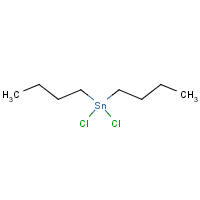Di-n-butyltin dichloride
Agent Name
Di-n-butyltin dichloride
CAS Number
683-18-1
Formula
C8-H18-Cl2-Sn
Major Category
Metals

Synonyms
Chlorid di-n-butylcinicity [Czech]; Di-n-butyl-zinn-dichlorid [German]; Dibutyldichlorostannane; Dibutyldichlorotin; Dibutylstannium dichloride; Dibutyltin chloride; Dibutyltin dichloride; Dichlorodibutylstannane; Dichlorodibutyltin; Stannane, dibutyldichloro-; Tin, dibutyl-, dichloride; [ChemIDplus] UN3146
Category
Tin Compounds, Organic
Description
White solid; mp = 43 deg C; [Hawley] White paste with an acrid odor; mp = 39-41 deg C; [MSDSonline]
Sources/Uses
Used as organotin intermediate, a general-purpose stabilizers for polyvinyl chloride, an esterification catalyst, and a veterinary vermicide and tapeworm remedy; [HSDB]
Comments
In lethal dose studies by intravenous route, causes somnolence (general depressed activity), chronic pulmonary edema, and liver injury; Oral LD50 (rat) = 50 mg/kg; Intravenous LDLo (rat) = 10 mg/kg; [ChemIDplus] A strong skin and eye irritant; A potent immunotoxin--causes thymus lymphocyte depletion in animal experiments; [HSDB] A delayed skin, eye, and respiratory tract irritant; [INCHEM] Can cause burns; [eChemPortal: ESIS] May evolve hydrochloric acid on exposure to moisture; A corrosive substance that can cause injury to the skin, eyes, and respiratory tract; Can be absorbed through skin; [MSDSonline] See "Tin, organic compounds."
Biomedical References
Exposure Assessment
Skin Designation (ACGIH)
Yes
TLV (ACGIH)
0.1 mg/m3, as Sn
STEL (ACGIH)
0.2 mg/m3, as Sn
PEL (OSHA)
0.1 mg/m3, as Sn
MAK
0.1 mg/m3, inhalable fraction, as Sn
IDLH (NIOSH)
25 mg/m3, as Sn
Lethal Concentration
LC50 (rat) >364 mg/m3/4h
Explanatory Notes
VP = 2 mm Hg at 100 deg C; [HSDB] The Guide in the Emergency Response Guidebook is for "Organotin compound, solid, n.o.s." Organic tin compounds have a "skin" designation and are classified as "A4" (Not classifiable as human carcinogen); [ACGIH]
Adverse Effects
Neurotoxin
Other CNS neurotoxin
Hepatotoxin
Hepatoxic (a) from occupational exposure (secondary effect) or (b) in animal studies or in humans after ingestion
Dermatotoxin
Skin burns
ACGIH Carcinogen
Not Classifiable
Diseases, Processes, and Activities Linked to This Agent
Other Information
No other related information on this agent was found.